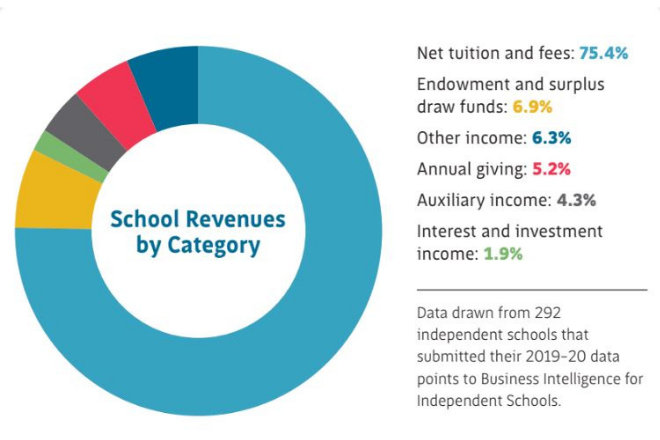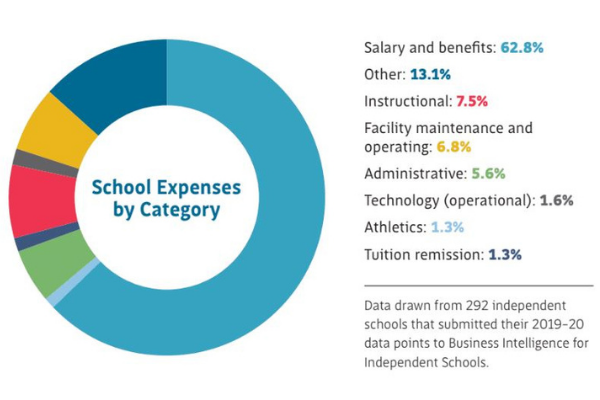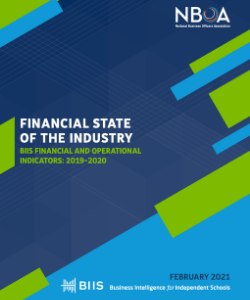Article by Elizabeth Dabney
A first look at the 2019-20 school year data collected in Business Intelligence for Independent Schools (BIIS) this past fall suggests that it’s too early to fully assess the financial effects of the pandemic on the independent school industry. Overall, 64% of schools ended 2019-20 with an unrestricted operating surplus, and 36% had an unrestricted operating deficit. This method of calculating surplus and deficit includes a broader set of unrestricted revenues and expenses than are usually in a school’s operating budget.
Revenue
Net tuition and fees continue to be the primary source of income for independent schools — 75.4% of revenue, increasing from 72% in 2018-19. The percentage of revenue drawn from the endowment and surplus funds increased from 5.9% in 2018-19 to 6.9% in 2019-20. The proportion of revenue from interest and investment income decreased from 3.2% to 1.9%. Auxiliary income decreased from 5.6% to 4.3% of revenue.
Among the 231 schools that participated in BIIS in both 2019 and 2020, 58% of schools had an increase in income, 41% experienced a decrease and 1% saw no change. As an industry already heavily reliant on tuition as a main source of income, it will be important to keep an eye on changes in the percentage of income from sources that “fill the gap” between the amount of tuition charged and the cost to educate students.

Expenses
Salary and benefits remain schools’ largest expense, increasing from 60.7% of expenses in 2018-19 to 62.8% in 2019-20. Instructional salary and benefits accounted for 66% of total salary and benefits. Administrative salary and benefits accounted for 23% with the remaining 11% going towards other staff such as in facility maintenance and technology.
The proportion of expenses spent on facility maintenance and technology — two school areas potentially most affected by the pandemic — remained steady from the prior school year. The proportion dedicated to administrative expenses decreased from 6.3% to 5.6%.
Among 231 schools that participated in BIIS in both 2019 and 2020, 59% of schools had an increase in expenses, 39% experienced a decrease and 2% saw no change. More than half of schools with boarding (53%) had a decrease in expenses compared to 37% of day schools. It remains to be seen what expenses schools incurred in response to the pandemic will “stick” after the pandemic ends.
Tuition discounting plays an important role in schools’ tuition models, with an industry-wide discount as a percent of gross tuition and fees of 16.8% in 2019-20. Need-based aid is the largest proportion of this discount at 13.5%.
Given the timing of the start of the pandemic in the U.S., late in the 2019-20 school year, these results are not surprising. Furthermore, these findings reflect what we heard from you in our COVID-19 flash surveys in the spring and summer of 2020. Some business officers expressed confidence in being able to weather the financial storm in the short term but were more concerned about the financial effects of the pandemic in 2020-21 and beyond. Fluctuating enrollment, new health and safety expenses and program delivery modes that flip between in-person and virtual may strain school finances. The 2019-20 data will likely be the baseline we return to as we continue to understand the financial effects of the pandemic on independent schools.

Download a PDF of this article.




